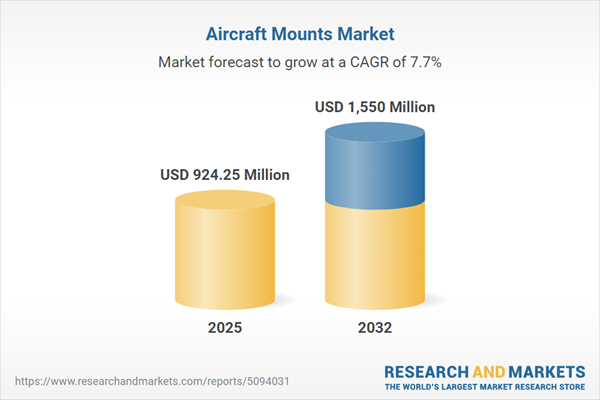Speak directly to the analyst to clarify any post sales queries you may have.
The aircraft mounts market is evolving as aviation leaders prioritize robust, adaptable mounting solutions amid regulatory demands and advancing aerospace technologies. This report offers actionable insights for senior executives seeking to optimize procurement, compliance, and operational performance in this dynamic sector.
Market Snapshot: Aircraft Mounts Market Outlook
The global aircraft mounts market is projected at USD 857.23 million in 2024 and forecasted to reach USD 924.25 million by 2025, translating to a CAGR of 7.72%. Sustained growth is anticipated through 2032 as innovation in mounting materials, noise reduction systems, and digital procurement adoption drive advancements across commercial, cargo, military, and general aviation segments. Leaders in aviation are directing resources towards mounting systems that align with shifting regulatory requirements, enhance operational efficiency, and facilitate integration with legacy and next-generation aircraft. Modernization of procurement processes and alignment across international markets are further accelerating adoption and sector cohesion.
Scope & Segmentation of the Aircraft Mounts Market
This comprehensive analysis informs procurement, supply chain, and operations executives about pivotal segments and high-impact opportunities. The following dimensions of the aircraft mounts market support strategic decision-making and risk management:
- Mount Types: Adjustable and fixed mounts, including elastomeric, neoprene, rubber-based, metallic spring, and pneumatic designs, serve distinct needs for vibration isolation and compliance with structural standards.
- Material Selection: Advanced composites such as carbon fiber, glass fiber, aluminum, stainless steel, titanium, and specialized rubber formulations enhance durability and compatibility with both traditional and contemporary aircraft fleets.
- Application Segments: Mounting solutions are tailored for commercial, cargo, military, and general aviation roles, suited to both fixed-wing and rotary platforms, and designed for diverse operating environments.
- Distribution Channels: Sourcing options have expanded from traditional aftermarket routes to include advanced digital procurement platforms, giving supply chain teams greater adaptability and transparency.
- Geographic Reach: Market strategies must address the specific commercial and regulatory circumstances of the Americas, Europe, Asia-Pacific, and Middle East and Africa, recognizing distinct regional requirements and growth drivers.
- Industry Leaders: Major contributors such as Collins Aerospace, Parker-Hannifin, Moog Inc., Safran S.A., Eaton Corporation, TransDigm, Honeywell, BAE Systems, GKN Aerospace, and Meggitt shape industry direction through research and robust production capabilities.
Key Takeaways for Senior Decision-Makers
- Composite material integration assists operators in achieving standards for environmental compliance and sustained aircraft performance, ensuring viability across a wide fleet range.
- Trends in electric propulsion, automation, and urban air mobility increase the need for mounting solutions that stabilize vibration and maximize equipment lifespan.
- Embedded analytics and system connectivity support predictive maintenance and elevate global operational readiness insights for fleet managers.
- Strong supplier and partner relationships are critical for maintaining operational continuity and flexibility, particularly during market fluctuations or disruptions.
- The adoption of digital sourcing platforms increases procurement agility, transparency, and responsiveness to evolving compliance or supply chain challenges.
- Investment in engineering collaboration and agile production processes expedites the deployment of new technologies and supports resilient aircraft operations under dynamic conditions.
Tariff Impact on Aircraft Mounting Components
Recent tariff actions in the United States have led suppliers to reexamine sourcing approaches and logistics pathways. This shift highlights the necessity for regional supplier alignment, updated contractual frameworks, and rigorous compliance tracking across supply chains. Resilient global aftermarket infrastructures are increasingly vital for maintaining operational stability as cost structures and supplier networks adjust.
Methodology & Data Sources
This report synthesizes extensive secondary research, technical assessments, and direct input from aerospace engineers and MRO professionals. Scenario analysis, supported by independent review, reinforces the relevance and reliability of insights presented for procurement and supply chain decision-makers in the aircraft mounts market.
Why This Report Matters
- Provides actionable intelligence to inform sourcing strategies and fortify supplier networks resilient to compliance and industry shifts.
- Delivers up-to-date guidance on material innovation, technical advances, and digital procurement trends that mitigate risks and elevate operational outcomes.
- Prepares organizations to respond quickly to sector changes and supports ongoing, well-informed aviation operations across global markets.
Conclusion
Senior aviation executives can rely on this report as a strategic resource to strengthen procurement, bolster supply chain resilience, and drive effective adaptation in the changing aircraft mounts market.
Additional Product Information:
- Purchase of this report includes 1 year online access with quarterly updates.
- This report can be updated on request. Please contact our Customer Experience team using the Ask a Question widget on our website.
Table of Contents
3. Executive Summary
4. Market Overview
7. Cumulative Impact of Artificial Intelligence 2025
Companies Mentioned
The companies profiled in this Aircraft Mounts market report include:- Collins Aerospace, Inc.
- Parker-Hannifin Corporation
- Moog Inc.
- Safran S.A.
- Eaton Corporation PLC
- TransDigm Group Incorporated
- Honeywell International Inc.
- BAE Systems PLC
- GKN Aerospace Services Limited
- Meggitt PLC
Table Information
| Report Attribute | Details |
|---|---|
| No. of Pages | 180 |
| Published | November 2025 |
| Forecast Period | 2025 - 2032 |
| Estimated Market Value ( USD | $ 924.25 Million |
| Forecasted Market Value ( USD | $ 1550 Million |
| Compound Annual Growth Rate | 7.7% |
| Regions Covered | Global |
| No. of Companies Mentioned | 11 |









